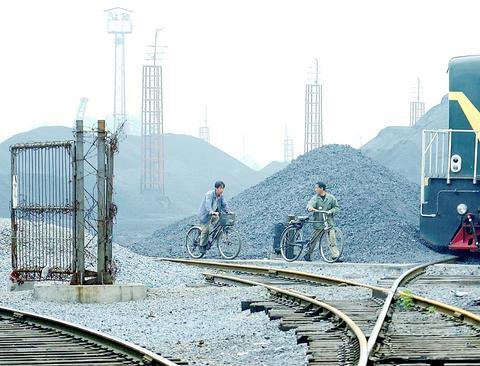In a return to the days of command planning, China yesterday ordered provincial governments to cap price increases in a bid to rein in inflationary pressures and slow down its runaway economy.
Provincial governments will be barred from raising any prices for three months when local consumer prices rise more than 1 percent from the previous month or by more than 4 percent from a year earlier for three months in a row, the State Development and Reform Commission (SDRC) said on its Web site.
In areas where the Consumer Price Index (CPI) does not breach the SDRC's ceiling, authorities have been told to control the timing of any price increases and make sure there are no sudden and sharp fluctuations.

PHOTO: REUTERS
Those who violate the mandate will be punished, the commission said.
China's leaders are resorting to central planning edicts to cool growth after inflation accelerated to 3 percent in March amid a 43 percent first-quarter jump in fixed-asset investment. The effectiveness of the latest measures may be limited because the government has less control over prices than in the past, analysts including Li Mingliang, said.
"The prices of 90 percent of commodities are decided by the market, rather than the government," said Li, of Haitong Securities Co in Shanghai.
Still, local governments "don't cooperate well with the nation's macroeconomic control and are inclined to raise prices for short-term profit," Li said.
Premier Wen Jiabao (
The State Council, or Cabinet, last month increased curbs on lending for new projects in industries that are expanding too rapidly, including steel, real estate and aluminum, and halted the building of a US$1.3 billion steel mill. China's banking regulator also ordered banks to stop lending for projects in some industries.
China's reliance on administrative fiat to engineer a slowdown echoes previous attempts to rein in periods of excessive growth under former premiers Zhu Rongji (朱鎔基) and Li Peng (李鵬).
Under Zhu, then vice premier in charge of economic policy and central bank governor, the economy slowed to 7.1 percent growth in 1999 form 12.8 percent in 1994. Under Li, growth dropped to 3.8 percent in 1990 from 11.3 percent in 1988.
The price restrictions are mainly aimed at service areas of the economy, such as suppliers of water, electricity, gas and healthcare -- segments where higher charges would hurt lower income groups.
"It reflects the concern of policy makers about inflation, basically in the low income segments of the population, where increases could generate social instability," said Deutsche Bank economist Ma Jun.
China's roaring economy has showed few signs of braking, expanding 9.7 percent last quarter after 9.9 percent in the three months to December.
To blame is soaring fixed-asset investment, which rose 43 percent in the first quarter, fuelling inflationary pressures in sectors such steel and construction.
Cooling measures aimed at these overheated sectors have so far failed to temper the world's sixth largest economy, which surged 9.1 percent last year, and has led to mounting fears of an investment bubble as prices march higher.
Central government leaders, including planning commission head Ma Kai (
The CPI is close the six and a half-year high of 3.2 percent reached in January. Inflation may approach 5 percent in May, June and July because the SARS epidemic depressed prices in the comparable months last year, a senior central bank official said last month.

SECURITY: As China is ‘reshaping’ Hong Kong’s population, Taiwan must raise the eligibility threshold for applications from Hong Kongers, Chiu Chui-cheng said When Hong Kong and Macau citizens apply for residency in Taiwan, it would be under a new category that includes a “national security observation period,” Mainland Affairs Council (MAC) Minister Chiu Chui-cheng (邱垂正) said yesterday. President William Lai (賴清德) on March 13 announced 17 strategies to counter China’s aggression toward Taiwan, including incorporating national security considerations into the review process for residency applications from Hong Kong and Macau citizens. The situation in Hong Kong is constantly changing, Chiu said to media yesterday on the sidelines of the Taipei Technology Run hosted by the Taipei Neihu Technology Park Development Association. With

CARROT AND STICK: While unrelenting in its military threats, China attracted nearly 40,000 Taiwanese to over 400 business events last year Nearly 40,000 Taiwanese last year joined industry events in China, such as conferences and trade fairs, supported by the Chinese government, a study showed yesterday, as Beijing ramps up a charm offensive toward Taipei alongside military pressure. China has long taken a carrot-and-stick approach to Taiwan, threatening it with the prospect of military action while reaching out to those it believes are amenable to Beijing’s point of view. Taiwanese security officials are wary of what they see as Beijing’s influence campaigns to sway public opinion after Taipei and Beijing gradually resumed travel links halted by the COVID-19 pandemic, but the scale of

A US Marine Corps regiment equipped with Naval Strike Missiles (NSM) is set to participate in the upcoming Balikatan 25 exercise in the Luzon Strait, marking the system’s first-ever deployment in the Philippines. US and Philippine officials have separately confirmed that the Navy Marine Expeditionary Ship Interdiction System (NMESIS) — the mobile launch platform for the Naval Strike Missile — would take part in the joint exercise. The missiles are being deployed to “a strategic first island chain chokepoint” in the waters between Taiwan proper and the Philippines, US-based Naval News reported. “The Luzon Strait and Bashi Channel represent a critical access

Pope Francis is be laid to rest on Saturday after lying in state for three days in St Peter’s Basilica, where the faithful are expected to flock to pay their respects to history’s first Latin American pontiff. The cardinals met yesterday in the Vatican’s synod hall to chart the next steps before a conclave begins to choose Francis’ successor, as condolences poured in from around the world. According to current norms, the conclave must begin between May 5 and 10. The cardinals set the funeral for Saturday at 10am in St Peter’s Square, to be celebrated by the dean of the College